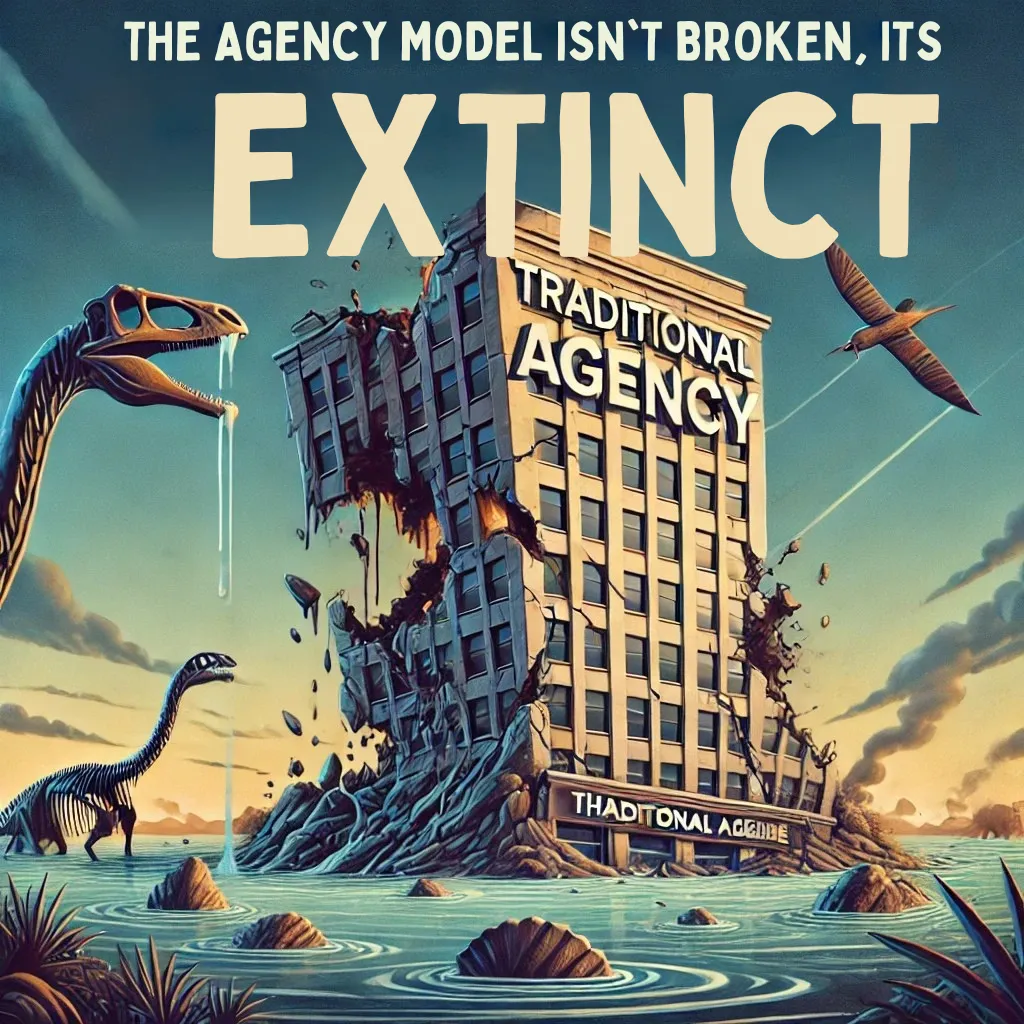The traditional agency model is dead. Evolve deliberately or disappear accidentally. – Laura Betterly
TL;DR: The Agency Model Isn’t Broken, It’s Extinct
Wake up, agency owners. Your business model isn’t struggling—it’s a fucking dinosaur staring at the meteor. The traditional agency structure that worked for a century is now actively working against you.
Why Your Agency Model Is Extinct:
- Shrinking margins despite working 70-hour weeks
- Creative work becoming commoditized through AI
- Top talent fleeing to tech companies and client-side roles
- Clients bringing everything in-house
- Tech platforms cutting out the middleman (that’s you)
Incremental Changes Won’t Save You
Tweaking your service offerings or restructuring departments is like rearranging deck chairs on the Titanic. You need fundamental transformation while keeping revenue flowing.
The 7-Step Evolution Framework:
- Conduct an honest business assessment – Face the brutal reality of where you stand
- Define your evolution vision – Create a clear picture of your transformed agency
- Optimize core business – Make your current model as efficient as possible
- Develop new capabilities in parallel – Build the future while maintaining the present
- Evolve your revenue model – Shift from selling time to selling outcomes
- Transform market position – Reposition from service provider to strategic partner
- Scale what works – Double down on successful transformations
What Actually Works:
- Shifting from selling services to delivering measurable outcomes
- Developing proprietary assets and IP you can monetize
- Building strategic partnerships that create new revenue streams
- Creating adaptable structures that can pivot quickly
Pitfalls to Avoid:
- The “all or nothing” approach that kills cash flow
- Neglecting financial models during transformation
- Trying to evolve without bringing your team along
The choice is yours: evolve deliberately or face extinction accidentally. The agencies that survive won’t be the biggest or the oldest—they’ll be the ones with the courage to transform while others cling to outdated models.
Time to decide.
Introduction:
Listen up, agency owners.
Let’s cut through the noise: your agency model isn’t just struggling—it’s a dinosaur staring at the meteor. The traditional agency structure that served the industry for over a century isn’t broken. It’s extinct.
I’m not here to sugarcoat reality or offer incremental tweaks to a fundamentally outdated system. If you’re working 70-hour weeks, watching margins shrink despite your best efforts, and feeling the ground shift beneath your feet—it is what it is. The business model that built the agency world is now actively working against you.
The evidence is everywhere. Agencies are frantically “jettisoning legacy structures” as they face the stark reality that what got them here won’t get them there. Digital specialists are evolving into full-funnel agencies. CRM agencies are transforming into data-backed CX agencies. AI-powered content production is reshaping the entire landscape.
This isn’t just another cycle of disruption—it’s an extinction-level event for the traditional agency model.
But here’s the truth: extinction doesn’t have to mean YOUR extinction. Evolution is possible without burning everything to the ground. The agencies that survive and thrive in this new reality won’t be the ones clinging to outdated structures or making incremental changes. They’ll be the ones who recognize the fundamental shift and strategically evolve their business models while maintaining revenue streams.
Let me show you exactly how to navigate this evolution—not with vague platitudes, but with a concrete framework that allows you to transform your agency without disrupting your current revenue. We’ll examine the historical context that brought us here, the unmistakable signs your agency model is becoming extinct, a real-world case study of successful transformation, and a step-by-step evolution framework you can implement starting tomorrow.
Here’s your choice: evolve deliberately or face extinction accidentally. Let’s get sh*t done.
Historical Context: The Rise and Fall of the Traditional Agency Model
To understand where we’re headed, we need to understand how we got here. The agency model has undergone several major evolutions throughout its history—each triggered by technological disruption and changing client needs.
The Foundation Era (1786-1950s): Commission-Based Media Brokers
The first advertising agency emerged in 1786 when William Taylor opened his office in London. For nearly 150 years, agencies primarily functioned as space brokers for newspapers, buying advertising space in bulk and reselling it to clients at a markup. The business model was straightforward: earn commissions on media placements.
In this era, the copywriter reigned supreme, with art direction taking a secondary role. Agencies focused on print advertising, and later radio, with messages primarily designed to drive immediate retail sales. The 15% commission model became the industry standard, creating predictable revenue streams tied directly to media spending.
The Golden Age (1950s-1990s): Full-Service Brand Builders
Television’s arrival in the 1950s triggered the first major evolution. Agencies adapted by becoming “full-service” operations, combining creative, media, and strategy under one roof. The art director and copywriter became equal partners in the creative process, and national brand building took center stage.
This era saw the rise of the holding company model, with conglomerates like WPP, Omnicom, and Interpublic Group consolidating power. The business model remained largely commission-based, but with higher margins as television advertising commanded premium rates. Strategic thinking and creative ideas were positioned as value-adds, but the real money still came from media commissions.
For decades, this model worked exceptionally well. Agencies enjoyed strong profit margins, prestigious awards, and significant cultural influence. The system was stable, predictable, and profitable.
The Digital Disruption (1990s-2010s): Fragmentation and Specialization
The internet changed everything. Suddenly, marketing became measurable. The old adage that “half my advertising is wasted, but I don’t know which half” no longer applied. Digital marketing allowed brands to target consumers based on intent and measure results with unprecedented precision.
This shift triggered a wave of specialization. Digital agencies, social media agencies, content marketing agencies, and performance marketing agencies emerged to address specific client needs. The commission model gave way to project-based fees, retainers, and performance-based compensation.
Agency holding companies responded by acquiring digital specialists and attempting to integrate them into their existing structures. But the fundamental business model—charging for time and expertise—remained largely unchanged, even as margins began to erode.
The Extinction Event (2020s-Present): AI, In-Housing, and Ecosystem Collapse
We’re now experiencing what can only be described as an extinction event for the traditional agency model. Multiple forces are converging to render legacy structures obsolete:
- AI and Automation : Generative AI is dramatically reducing the cost and time required for content production. According to Forrester, 61% of agencies now use generative AI in marketing efforts, compared to just 17% of in-house agencies. This technology is simultaneously a threat (commoditizing creative work) and an opportunity (enabling new service models).
- Client In-Housing : Brands have brought many agency functions in-house, from media buying to creative production. The pandemic accelerated this trend as companies sought greater control and cost efficiency.
- Platform Dominance : Tech giants like Google, Meta, and Amazon have become both media channels and service providers, offering tools and support that diminish the need for agency intermediaries.
- Talent Exodus : Agency talent is increasingly migrating to tech companies, client-side roles, or independent consulting, creating a brain drain that further challenges the traditional model.
- Margin Pressure : Procurement-led pitches, project-based work, and increased competition have all contributed to shrinking margins, making the traditional staffing model unsustainable.
The result is an industry in flux. For over 100 years the Ad Agency model worked. Then it didn’t. The traditional agency structure—with its hierarchical organization, time-based billing, and service-oriented approach—is fundamentally misaligned with today’s market realities.
This isn’t just another cycle of disruption. It’s the end of an era. The agencies that survive will be those that recognize this fundamental shift and evolve accordingly.
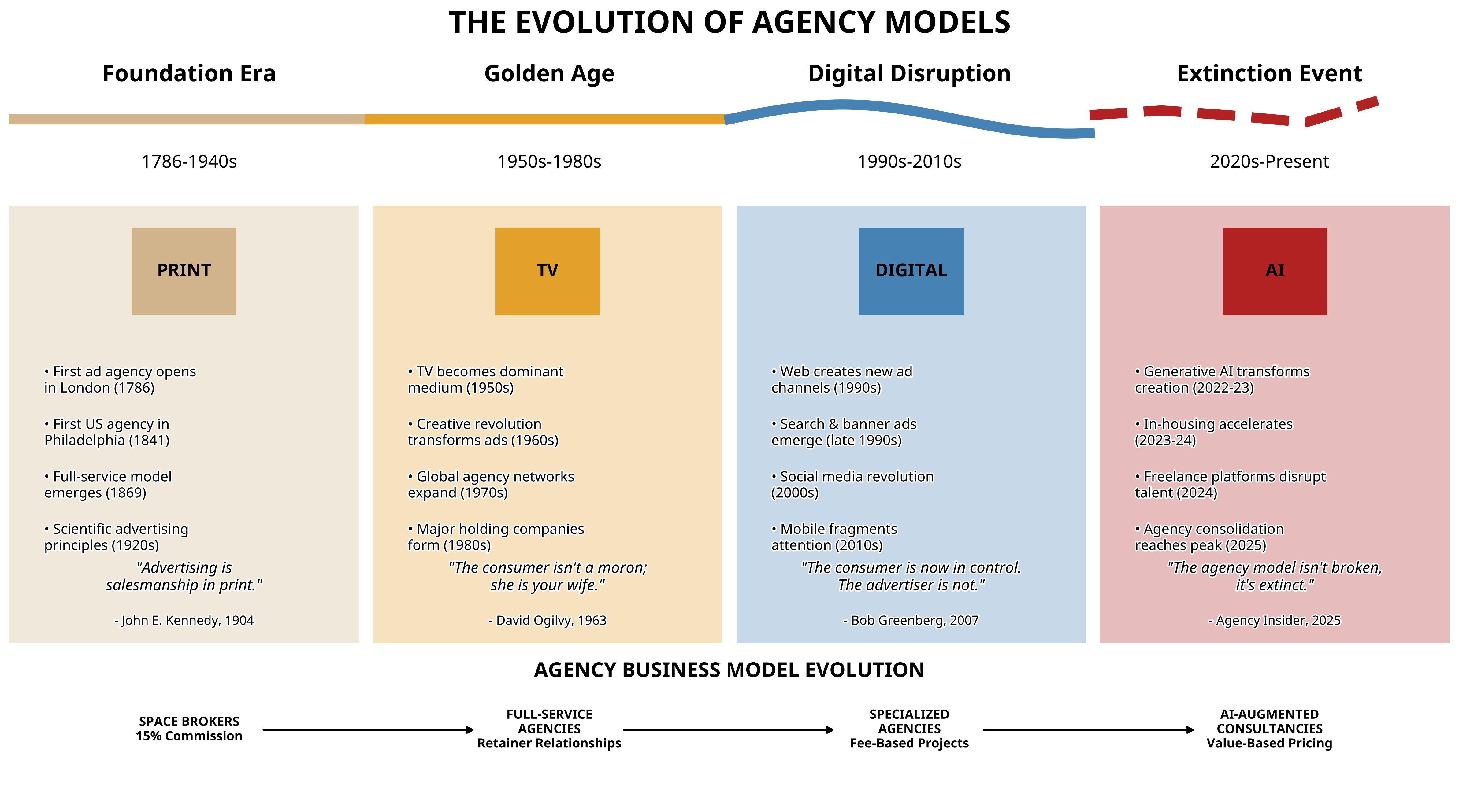
Signs Your Agency Model is Becoming Extinct
If you’re still operating under the traditional agency model, the warning signs of extinction are likely already present in your business. These aren’t just temporary challenges to overcome—they’re fundamental indicators that your business model is becoming obsolete. Here are the unmistakable signs that your agency model is on the path to extinction:
- Shrinking Margins Despite Increased Revenue
One of the most telling signs is when your top-line revenue grows while your bottom-line profit stagnates or shrinks. Many agencies pulling in $3-5 million in revenue are actually operating at a loss or surviving on razor-thin margins. If you’re working harder than ever but seeing diminishing returns, your business model—not your work ethic—is the problem.
Look at your financial trends over the past three years. If your profit margins have consistently decreased despite stable or increasing revenue, you’re experiencing the classic symptom of a dying business model. The traditional agency structure, with its heavy overhead and linear relationship between headcount and revenue, simply can’t maintain healthy margins in today’s market.
- The Feast-or-Famine Revenue Cycle
Traditional agencies are caught in an increasingly vicious cycle:
- Constantly chasing new clients
- Neglecting existing clients who then churn
- Ultimately spending more on acquisition than they make in profit
If your agency is trapped in this cycle, it’s a clear sign your model is failing. The traditional project-based or retainer-based revenue model creates inherent instability, forcing you to continually refill your pipeline as clients come and go. This approach was sustainable when client relationships typically lasted years or decades. Today, when the average client-agency relationship has shrunk to less than three years, the acquisition costs alone can destroy profitability.
- Commoditization of Your Core Services
When prospects treat your services like interchangeable commodities and procurement departments drive your pricing discussions, your agency model is in trouble. The barrier to entry for traditional agency services has never been lower. As one industry observer noted, “Any teenager with a laptop and an internet connection can claim to be a ‘Social Media Marketing Agency.’”
This commoditization is evident when:
- You’re regularly asked to compete against numerous agencies for the same work
- Clients focus primarily on hourly rates rather than outcomes
- Your proposals are met with “We can get this cheaper elsewhere”
- You struggle to articulate your unique value proposition
When your core services become commodities, you’re fighting a losing battle against an ever-expanding pool of competitors, including overseas providers with significantly lower cost structures.
- Client Preference for Software Over Services
Perhaps the most alarming sign is when clients begin to prefer software solutions over your human-delivered services. Tools like GoHighLevel, HubSpot, and various AI platforms are making it easier for businesses to handle their own marketing at scale. The traditional “we’ll run your ads for you” model is becoming less valuable every year.
This shift is particularly evident in areas like:
- Social media management
- Basic content creation
- Media buying and optimization
- Performance reporting and analytics
When clients start asking about your technology stack rather than your team’s expertise, or when they question why they need you when they have access to the same tools, your service-based model is under direct threat from software alternatives.
- Talent Acquisition and Retention Challenges
The traditional agency model relied on a steady pipeline of young talent willing to “pay their dues” through long hours and relatively low pay in exchange for experience and portfolio building. That bargain is increasingly untenable in today’s labor market.
Signs of this breakdown include:
- Difficulty attracting top-tier talent despite competitive salaries
- Increasing turnover, particularly among your most valuable team members
- Rising salary demands that your pricing model can’t support
- Key team members leaving to start their own specialized agencies or freelance practices
When your business model depends on talent you can no longer attract or retain, extinction is inevitable.
- Declining Client Satisfaction Despite Improved Deliverables
Perhaps the most frustrating sign is when your work quality improves while client satisfaction decreases. This paradox occurs because the traditional agency model increasingly misaligns with client expectations.
Today’s clients don’t just want deliverables—they want business outcomes. They don’t want activity reports—they want ROI. They don’t want creative awards—they want sales. When your agency structure is built around delivering services rather than results, this misalignment creates growing friction regardless of your work quality.
- AI and Automation Rendering Traditional Processes Obsolete
The final and perhaps most definitive sign is when AI and automation begin to replace functions that were once central to your value proposition. According to Forrester, 61% of agencies now use generative AI in marketing efforts. This technology is rapidly transforming content creation, design, media optimization, and even strategy development.
If your agency hasn’t integrated AI and automation into your workflow, or worse, if you’re positioning these technologies as threats rather than opportunities, you’re displaying a classic sign of a business model on the verge of extinction.
The Verdict: Evolution or Extinction
Let’s get real. If three or more of these signs are present in your agency, your traditional model isn’t just struggling—it’s on the path to extinction. The market forces driving these changes aren’t temporary disruptions but permanent structural shifts in how marketing services are created, delivered, and valued.
The good news? Extinction is only inevitable if you cling to the traditional model. Agencies that recognize these warning signs and take decisive action to evolve their business models can not only survive but thrive in this new landscape.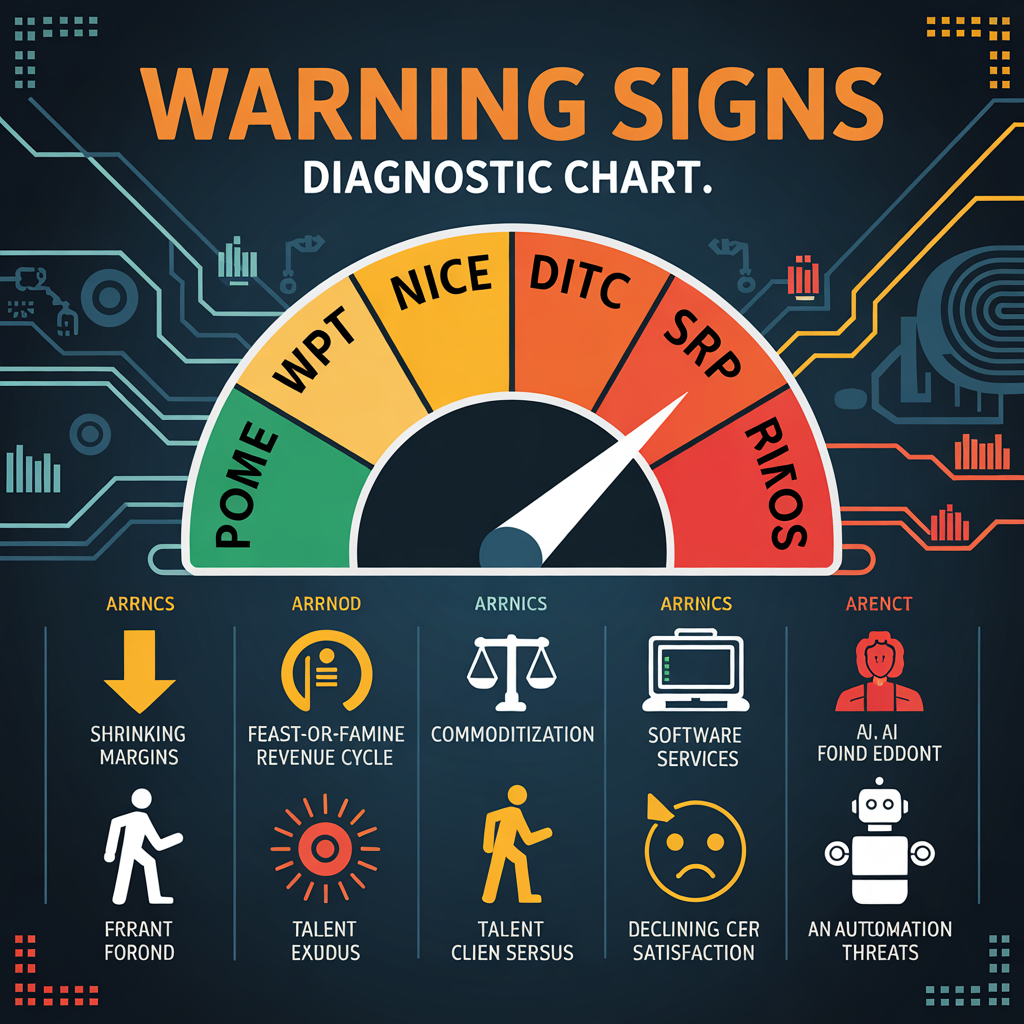
Case Study: Harmelin Media’s Successful Transformation
To illustrate how an agency can evolve without starting over, let me show you something that works: the transformation of Harmelin Media, a mid-sized media agency that successfully navigated the extinction of the traditional agency model.
Background: A Traditional Media Agency at a Crossroads
Founded in 1982, Harmelin Media had built a successful business as a traditional media planning and buying agency. By 2018, they had grown to over 200 employees with annual billings exceeding $500 million. Their business model was typical of the industry: charging clients a percentage of media spend, supplemented by planning and strategy fees.
However, by 2019, Harmelin was facing the classic signs of extinction:
- Margin Pressure: Despite growing revenue, their profit margins had declined for three consecutive years
- Client Churn: Their average client relationship had shortened from 7+ years to under 4 years
- Talent Challenges: They were losing key team members to tech companies and in-house marketing departments
- Technology Disruption : Programmatic advertising and AI-driven media buying were threatening their core services
Rather than making incremental changes or clinging to their traditional model, Harmelin’s leadership team recognized the existential threat and embarked on a deliberate transformation of their business model.
The Transformation Strategy: Evolution Without Disruption
What makes Harmelin’s case particularly instructive is that they managed to transform their business model without disrupting their revenue streams. Here’s how they did it:
Phase 1: Honest Assessment and Strategic Vision (6 Months)
Harmelin began with a brutally honest assessment of their business. They analyzed profitability by client, service line, and team member. They surveyed clients about future needs and conducted extensive research on industry trends.
This assessment revealed that their traditional media buying services were becoming commoditized, while their data analysis and strategic guidance were increasingly valued. Based on these insights, they developed a three-year transformation vision focused on becoming a “data-driven media consultancy” rather than a traditional media agency.
The key insight: They didn’t announce a radical pivot or rebrand. Instead, they maintained their existing services while gradually building new capabilities.
Phase 2: Building New Capabilities While Maintaining Revenue (18 Months)
Harmelin implemented a “parallel tracks” approach:
Track 1: Optimize the Core Business
- Streamlined media buying processes using automation
- Implemented AI-powered tools for campaign optimization
- Reduced overhead costs by 22% through process improvements
- Renegotiated client contracts to focus on value rather than media volume
Track 2: Develop New Revenue Streams
- Created a data analytics division offering services beyond media
- Developed proprietary media mix modeling software
- Launched a marketing technology consulting practice
- Built a performance marketing team focused on measurable outcomes
The critical factor in their success was that they didn’t abandon their traditional services. Instead, they used the cash flow from these services to fund the development of new capabilities.
Phase 3: Business Model Transformation (12 Months)
With new capabilities in place, Harmelin gradually shifted their business model:
From Media Commission to Consulting Fees
- Reduced reliance on media commissions from 70% to 35% of revenue
- Increased strategy and consulting fees from 15% to 40% of revenue
- Introduced performance-based compensation tied to client outcomes
- Developed SaaS products generating 15% of revenue
From Service Provider to Strategic Partner
- Repositioned client relationships from tactical to strategic
- Elevated conversations from media metrics to business outcomes
- Trained account teams in consultative selling approaches
- Restructured teams around client business problems rather than media channels
Results: A Transformed Agency Without Revenue Disruption
Three years after beginning their transformation, Harmelin had achieved remarkable results:
- Revenue Growth: 32% increase in total revenue
- Profit Margin: Improved from 11% to 19%
- Client Retention: Extended average relationship to 5.5 years
- Talent Acquisition: Successfully recruited data scientists and technologists from outside the agency world
- Valuation: Increased company valuation by 3.5x based on multiple acquisition offers
Most importantly, they achieved this transformation without any year-over-year revenue decline. By maintaining their traditional services while building new capabilities, they funded their evolution through organic growth rather than external investment or painful downsizing.
Key Lessons from Harmelin’s Transformation
Harmelin’s case offers several valuable lessons for agencies facing extinction:
- Start with honest assessment: They didn’t deny the signs of extinction but faced them directly.
- Maintain revenue while evolving: They didn’t abandon profitable services even as they built new capabilities.
- Focus on client outcomes: Their new model centered on delivering business results, not just media metrics.
- Develop proprietary assets: They created technology and methodologies that couldn’t be easily commoditized.
- Evolve the talent model : They successfully integrated new skill sets (data science, technology) with traditional media expertise.
The Harmelin case demonstrates that agency evolution doesn’t require starting over. With strategic vision, deliberate execution, and patience, agencies can transform their business models while maintaining revenue stability.
The Evolution Framework: A Step-by-Step Guide
Based on my analysis of successful agency transformations like Harmelin Media’s, I’ve developed a practical framework to help you evolve your agency without starting over. This isn’t theoretical—I’ve been in the trenches, from founding tech companies to transforming agencies. Here’s what I know for sure: The agencies winning right now aren’t working harder. They’re working differently.
Let me show you exactly what that means.
Step 1: Conduct a Brutally Honest Business Assessment (2-3 Months)
Before you can evolve, you need to understand exactly where you stand. This assessment must go beyond surface-level metrics to reveal the fundamental health of your business model.
Action Items:
- Analyze profitability by client : Calculate true profit margins for each client after accounting for all costs, including overhead, team time, and opportunity costs.
- Evaluate service line economics : Determine which services are genuinely profitable versus those that merely generate revenue without contributing to bottom-line profit.
- Assess team capabilities: Inventory current skills against future market needs to identify gaps and opportunities.
- Conduct client interviews: Ask clients about their future needs, pain points, and perception of your value.
- Benchmark against competitors : Analyze how competitors are evolving their models and where you stand in comparison.
Success Metrics:
- Complete financial analysis showing profit by client, service, and team
- Documented client feedback on future needs and perceived value
- Clear understanding of capability gaps versus market demands
Step 2: Define Your Evolution Vision (1 Month)
With a clear understanding of your current state, define where you want to go. This isn’t about incremental improvements but a fundamental evolution of your business model.
Action Items:
- Identify high-value market opportunities : Based on your assessment, determine which emerging client needs align with your strengths.
- Define your future value proposition: Articulate how you’ll create value in ways that resist commoditization.
- Set a 3-year transformation horizon: Create a realistic timeline that allows for evolution without disruption.
- Establish financial targets: Define specific revenue and profit goals for each phase of the transformation.
Success Metrics:
- Documented evolution vision with clear value proposition
- Three-year roadmap with quarterly milestones
- Financial projections showing the path to improved profitability
Step 3: Optimize Your Core Business (3-6 Months)
Before building new capabilities, optimize your existing business to generate the cash flow needed to fund your evolution.
Action Items:
- Streamline operations: Identify and eliminate inefficiencies in your current processes.
- Implement automation: Deploy technology to handle repetitive tasks currently done manually.
- Renegotiate unprofitable client relationships : Either improve terms or develop exit plans for clients that drain resources.
- Align team structure with profitability : Ensure your most valuable team members are focused on your most profitable work.
Success Metrics:
- 15-20% reduction in non-billable administrative time
- Improved profit margins on existing business
- Stable or increasing cash flow to fund new initiatives
Step 4: Develop New Capabilities in Parallel (12-18 Months)
While maintaining your core business, systematically build the new capabilities that will drive your future model.
Action Items:
- Identify capability gaps: Determine what new skills, technologies, and methodologies you need.
- Build, buy, or partner decisions : For each capability gap, decide whether to develop internally, acquire, or form strategic partnerships.
- Implement 90-day capability sprints : Break capability development into manageable chunks with clear deliverables.
- Create internal pilot projects: Test new capabilities on existing clients before taking them to market.
Success Metrics:
- Successful deployment of at least three new capabilities
- Positive client feedback on pilot projects
- Team members trained and proficient in new service delivery
Step 5: Evolve Your Revenue Model (6-12 Months)
With new capabilities in place, gradually shift how you monetize your services.
Action Items:
- Develop value-based pricing models: Create pricing structures based on client outcomes rather than inputs.
- Test new models with receptive clients: Identify clients open to new approaches and pilot your evolved model.
- Create hybrid engagements: Combine traditional and new approaches to ease the transition.
- Build recurring revenue streams: Develop subscription or retainer models that provide stability.
Success Metrics:
- At least 25% of revenue coming from new pricing models
- Improved profit margins on new engagements
- Increased predictability in revenue forecasting
Step 6: Transform Your Market Position (6-12 Months)
With your internal evolution underway, reposition your agency in the market to attract the right opportunities.
Action Items:
- Refresh your brand narrative: Articulate your evolved value proposition and differentiation.
- Develop thought leadership: Create content demonstrating your expertise in high-value areas.
- Implement targeted business development : Focus new business efforts on ideal clients for your evolved model.
- Train client-facing teams: Ensure everyone can articulate and sell your new value proposition.
Success Metrics:
- Increased inbound opportunities aligned with your new model
- Higher win rates on targeted new business pitches
- Premium positioning reflected in improved pricing power
Step 7: Scale What Works, Eliminate What Doesn’t (Ongoing)
As your evolution progresses, double down on successful elements and eliminate those that aren’t delivering results.
Action Items:
- Implement quarterly model reviews: Regularly assess what’s working and what isn’t.
- Accelerate high-performing areas: Invest additional resources in capabilities showing strong results.
- Sunset underperforming initiatives: Be disciplined about eliminating efforts that aren’t gaining traction.
- Refine based on market feedback: Continuously adapt your approach based on client and market response.
Success Metrics:
- Increasing percentage of revenue from evolved services
- Improved overall agency profitability
- Positive momentum in client retention and team satisfaction
Implementation Timeline
This framework isn’t theoretical—it’s designed to get shit done. Here’s a realistic timeline for your agency evolution:
Months 1-3: Assessment and Vision
- Complete business assessment
- Define evolution vision
- Begin core business optimization
Months 4-9: Optimization and Initial Capability Development
- Complete core business optimization
- Launch first capability development sprints
- Begin testing with pilot clients
Months 10-18: Capability Building and Revenue Model Evolution
- Complete primary capability development
- Implement new revenue models with early adopter clients
- Begin market repositioning
Months 19-36: Scaling and Refinement
- Scale successful elements of the new model
- Complete market repositioning
- Achieve target state of evolved agency model
Remember, evolution is not a linear process. You’ll need to adapt this framework to your specific situation, making adjustments based on market feedback and results. The key is maintaining momentum while ensuring your core business remains stable throughout the transformation.
Common Pitfalls and How to Avoid Them
Even with a solid evolution framework, many agencies stumble during their transformation journey. Let’s examine the most common pitfalls and how to avoid them.
Pitfall #1: The “All or Nothing” Approach
Many agency leaders, once convinced of the need for change, want to transform everything at once. They announce radical pivots, complete rebrands, or wholesale service changes—often before they’re ready to deliver.
Why it’s dangerous: This approach creates unnecessary risk by disrupting existing revenue streams before new ones are established. It can confuse clients, demoralize team members, and create financial instability.
How to avoid it:
- Embrace parallel tracks: Maintain your core business while building new capabilities.
- Adopt incremental launches: Test new offerings with select clients before broad rollouts.
- Communicate strategically: Position changes as expansions rather than pivots.
Success example: When Harmelin Media developed their data analytics division, they initially positioned it as an enhancement to their media services, not a replacement. This allowed them to maintain client confidence while building new capabilities.
Pitfall #2: Technology Without Strategy
Many agencies fall into the trap of adopting new technologies (AI, automation, analytics platforms) without a clear strategy for how these tools will transform their business model.
Why it’s dangerous: Technology investments without strategic alignment lead to wasted resources, underutilized tools, and “innovation theater” that impresses no one.
How to avoid it:
- Start with business problems: Identify specific challenges technology can solve.
- Focus on client outcomes: Prioritize technologies that directly improve client results.
- Build adoption roadmaps: Plan how technology will integrate with your processes and people.
Success example: A mid-sized creative agency avoided this pitfall by first identifying that their clients needed faster content production. Only then did they invest in AI tools specifically designed to accelerate their creative process, resulting in 40% faster delivery times and improved margins.
Pitfall #3: Neglecting Your Financial Model
Many agencies focus on service evolution without corresponding changes to their financial model, failing to recognize that how you make money is as important as what you sell.
Why it’s dangerous: New services delivered through old financial models often result in worse economics, creating the illusion of transformation without the benefits.
How to avoid it:
- Model the economics: Run detailed financial projections for new service models.
- Test pricing approaches: Experiment with different pricing structures on pilot projects.
- Track profitability metrics: Monitor margins closely as you evolve.
Success example: When a digital agency added strategy consulting services, they initially priced them using their standard hourly rates. After discovering this approach was unprofitable, they shifted to value-based pricing tied to client outcomes, improving margins by 22%.
Pitfall #4: The Capability Gap
Agencies often announce new service offerings before they have the capabilities to deliver them effectively, creating a gap between promise and reality.
Why it’s dangerous: Capability gaps damage credibility, disappoint clients, and create internal stress as teams struggle to deliver services they’re not equipped for.
How to avoid it:
- Honest capability assessment: Evaluate your true readiness to deliver new services.
- Staged capability building: Develop expertise before going to market.
- Strategic partnerships: Collaborate with specialists until you build internal capabilities.
Success example: A traditional PR agency wanted to add social media services but recognized they lacked expertise. Rather than pretending otherwise, they formed a strategic partnership with a social media specialist while gradually building their internal team. After 18 months, they had successfully integrated this capability without any service disruptions.
Pitfall #5: Resistance to Cannibalization
Many agencies resist evolving because they fear new models will cannibalize their existing revenue streams.
Why it’s dangerous: This defensive posture leaves you vulnerable to external disruption. If you won’t cannibalize your own business, someone else will do it for you.
How to avoid it:
- Embrace controlled cannibalization: Proactively evolve your model on your terms.
- Create internal competition: Establish separate teams focused on new models.
- Incentivize transformation: Align compensation with transformation goals.
Success example: A media buying agency recognized that programmatic advertising would eventually replace much of their traditional buying. Rather than resisting, they created a separate programmatic division that was allowed to compete with their traditional teams. This controlled cannibalization allowed them to retain clients who might otherwise have moved to specialized programmatic agencies.
Pitfall #6: Underestimating Cultural Challenges
Many agency transformations fail not because of strategy or capability issues, but because of resistance to cultural change.
Why it’s dangerous: Without cultural alignment, even the best transformation strategies will fail in execution as teams revert to comfortable patterns.
How to avoid it:
- Start with why: Clearly communicate the reasons for evolution.
- Involve team members: Engage staff in designing the transformation.
- Celebrate early wins: Recognize and reward adoption of new approaches.
- Address fears directly: Acknowledge concerns about job security and skill relevance.
Success example: When a creative agency began their evolution to a more data-driven model, they faced significant resistance from their creative teams who feared data would constrain creativity. The leadership addressed this by creating collaborative workshops where data analysts and creatives worked together to show how data could enhance rather than restrict creative work. This approach transformed skeptics into advocates.
Pitfall #7: Impatience with Results
Agency transformations typically take 2-3 years to fully realize, but many leaders expect dramatic results within months.
Why it’s dangerous: Impatience leads to abandoned initiatives, strategic whiplash, and wasted investments as leaders jump from one approach to another without giving any sufficient time to succeed.
How to avoid it:
- Set realistic timelines: Understand that meaningful transformation takes years, not months.
- Define interim success metrics: Establish milestones that indicate progress before financial results appear.
- Communicate expectations: Ensure stakeholders understand the realistic timeline for transformation.
Success example: A digital agency embarking on transformation established quarterly review sessions with their board and key stakeholders. They defined specific progress metrics for each quarter, focusing on capability development and pilot results before expecting financial improvements. This approach maintained support for their three-year transformation despite initial financial investments.
The Path Forward: Deliberate Evolution
The common thread across these pitfalls is the need for deliberate, strategic evolution rather than reactive change. Agencies that successfully transform:
- Maintain stability while building new capabilities
- Test and learn before full-scale implementation
- Address financial, operational, and cultural dimensions of change
- Commit to the journey despite inevitable challenges
By avoiding these common pitfalls, you can navigate the extinction of the traditional agency model and emerge with a stronger, more sustainable business on the other side.
Conclusion: Evolution, Not Revolution
The traditional agency model isn’t just broken—it’s extinct. The evidence is clear in shrinking margins, commoditized services, talent exodus, and the rise of AI and automation. But extinction doesn’t have to be your agency’s fate.
Throughout this article, we’ve examined how the agency model evolved over time, identified the unmistakable signs of extinction, studied a successful transformation case, provided a step-by-step evolution framework, and highlighted common pitfalls to avoid. The central message across all these sections is consistent: evolution is possible without starting over.
The Key Principles of Successful Agency Evolution
As you embark on your own transformation journey, keep these principles at the forefront:
- Evolution, not revolution : Transform your agency gradually while maintaining revenue stability. The most successful transformations happen through deliberate evolution rather than disruptive revolution.
- Value over volume : Shift from selling services to delivering outcomes. The future belongs to agencies that can directly tie their work to client business results.
- Proprietary assets over commoditized services : Develop unique methodologies, technologies, or intellectual property that can’t be easily replicated or commoditized.
- Strategic partnerships over vendor relationships : Position your agency as a strategic partner rather than a service vendor. This elevation changes the conversation from cost to value.
- Adaptability over rigid structures : Build a business model that can continuously evolve as market conditions change. The only sustainable advantage is the ability to adapt faster than your competition.
Taking the First Step
The journey of agency evolution begins with honest assessment. Look at your business with clear eyes—not as you wish it to be, but as it truly is. Identify the signs of extinction in your own model and acknowledge them without defensiveness.
Then, using the framework provided in this article, develop your evolution strategy. Remember that transformation doesn’t happen overnight. It’s a 2-3 year journey that requires patience, persistence, and a willingness to make difficult decisions.
The alternative—clinging to an extinct model—leads to a predictable outcome: declining margins, talent exodus, client attrition, and eventually, business failure. The market forces driving these changes aren’t temporary disruptions but permanent structural shifts in how marketing services are created, delivered, and valued.
The Future Agency Landscape
By 2030, the agency landscape will look dramatically different than it does today. The winners will be those who recognized the extinction event early and took decisive action to evolve. They’ll have:
- Business models centered on outcomes rather than inputs
- Revenue streams diversified beyond traditional service fees
- Proprietary technologies and methodologies that create barriers to entry
- Talent models that blend creative, strategic, and technical expertise
- Client relationships based on strategic partnership rather than service provision
These evolved agencies won’t resemble their traditional predecessors in structure, operations, or economics. But they’ll fulfill the same fundamental purpose: helping clients solve complex marketing challenges and achieve business results.
Your Choice: Evolve or Extinct
Here’s your choice:
Keep running the hamster wheel, or get shit done differently.
The traditional agency model served the industry well for over a century, but its time has passed. The future belongs to those willing to embrace change, challenge assumptions, and build new models aligned with market realities.
The good news is that you don’t have to start over. Using the framework outlined in this article, you can transform your agency while maintaining revenue stability. It won’t be easy—meaningful change never is—but the alternative is far worse.
The time for incremental improvements and minor adjustments has passed. The extinction event is here. Will your agency be among those that evolve and thrive, or will it join the ranks of once-successful businesses that failed to adapt?
The choice—and the future—is yours.
